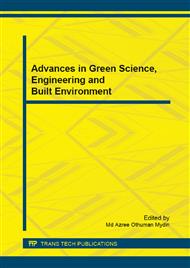p.40
p.44
p.48
p.52
p.56
p.60
p.64
p.68
p.72
Evaluating the Customs and Rituals of the Malay Culture and its Contribution on Space Design in Modern Terrace House
Abstract:
In the year 1972, UNESCO has defined the term ‘Malay’ as a tribe in Peninsular Malaysia, Thailand, Indonesia, Filipina, and Madagascar. On the other hand, there was a report about two types of definition in terms of law and anthropology regarding the ‘Malay’. According to constitution in case 160(2), Malays have been defined as a person who is Islam, speaks the Malay language, practices the Malay culture and tradition, born before independence day whether in official Malay Federation grounds or in Singapore or, on the day of independence and he or she is a resident in the federation or in Singapore . A Malaysian Anthropologist, Syed Husin Ali stated that the Malay people are brown skinned, average built but robust as well as polite and rather poetic in terms of appearance . In terms of Ethnology, Malay means a group of community that practices the heritage and generation system that was once applied in Mongoloid race . the aim of this paper is to find out the meaning of ‘culture’, its importance, what is our culture and how culture can be used in this research and how culture can be considered in the design of terrace house in the future.
Info:
Periodical:
Pages:
56-59
Citation:
Online since:
March 2015
Authors:
Keywords:
Price:
Сopyright:
© 2015 Trans Tech Publications Ltd. All Rights Reserved
Share:
Citation:


